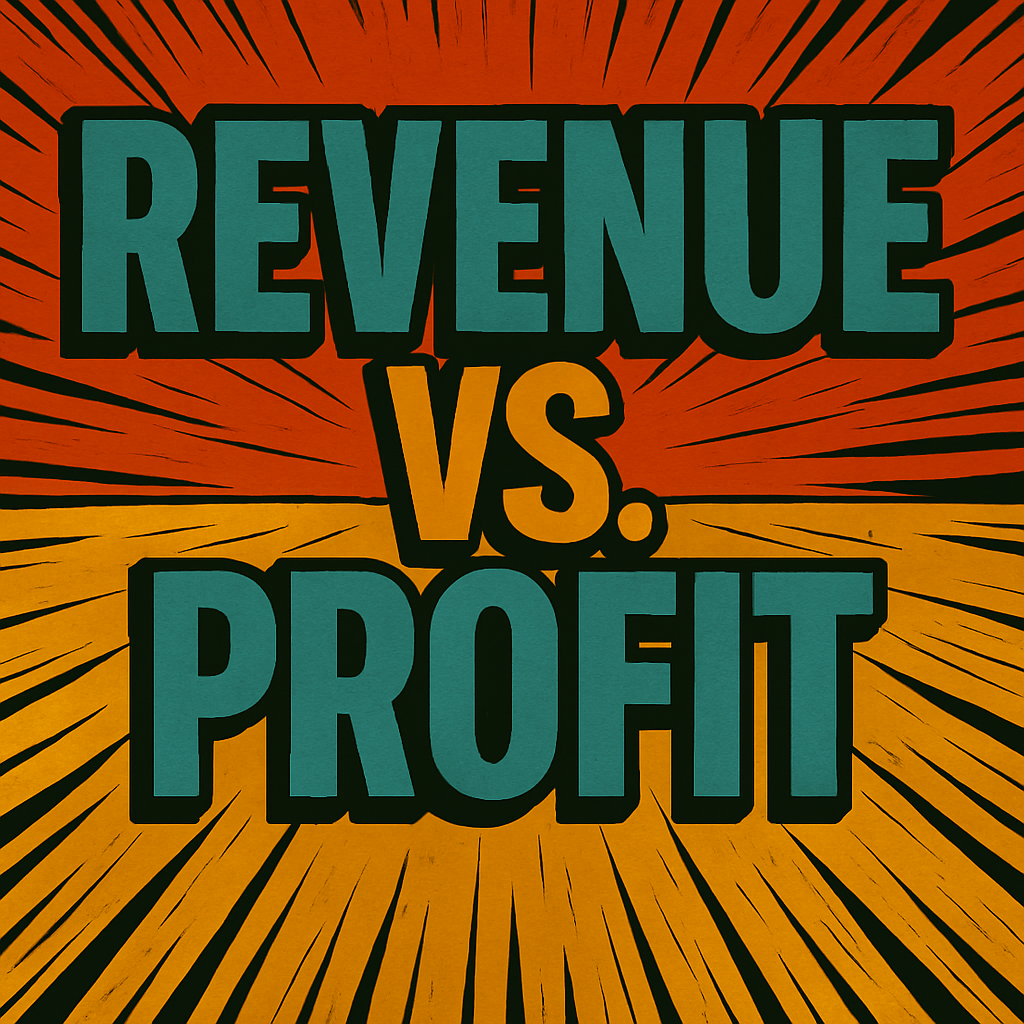Revenue vs. Profit
“Revenue is the game, profit is the score”

Revenue vs. Profit: Clarifying Margins and Misconceptions
Revenue vs. Profit is one of those deceptively simple topics that trips up a lot of owners and managers.
Many business leaders see strong sales numbers and assume the business is thriving, but revenue alone doesn’t account for costs, margins, or debt obligations. A company can be growing top-line sales while losing money at the bottom line. Without clearly separating revenue from profit, owners risk overestimating financial health, overspending, or misjudging growth opportunities.
Revenue is the total income a business brings in from sales before any expenses are deducted.
It’s often called the “top line.”Profit is what’s left after subtracting costs from revenue. It’s often called the “bottom line”.
Profit can be measured at different levels (gross profit, operating profit, net profit).
…In short: Revenue shows size, profit shows strength.
Common Misconceptions
“High sales = high profit.”
Not necessarily. Costs, discounts, and overhead can shrink margins dramatically.
“Revenue growth always means health.”
Without profit growth, expanding revenue can actually deepen financial strain.
“Profit is just one number.”
Not so…there are different types (gross, operating, net)…all tell different stories.

For Business Owners: Misreading revenue as profit leads to overconfidence in cash availability.
For Decision Makers: Understanding margin levels helps you spot whether growth is sustainable or just “busy but broke.”
For Lenders and Investors: Profitability tells whether the business model works, not just whether sales are happening.
Key Margins to Understand
Gross Profit Margin = (Revenue – Cost of Goods Sold) ÷ Revenue
Covers direct costs like materials, production labor, and shipping.
Shows how efficiently you produce or deliver goods/services.Operating Profit Margin = Operating Income ÷ Revenue
Accounts for overhead, payroll, and other operating costs.Net Profit Margin = Net Income ÷ Revenue
The final measure after taxes, interest, and all expenses — true “bottom line.”
📊 Practical Example: Revenue vs. Profit in Action
A company generates $1,000,000 in revenue.
- Costs of goods sold = $600,000 → Gross profit = $400,000 (40% margin).
- Operating expenses = $300,000 → Operating profit = $100,000 (10% margin).
- Taxes and interest = $50,000 → Net profit = $50,000 (5% margin).
Takeaway: Even with $1M in revenue, the company only keeps $50k in true profit.
Mini-Case: $1 Million in Sales, but Where’s the Profit?
A retail company proudly reports $1,000,000 in annual revenue. The owner assumes the business is doing great because sales are strong. But when the numbers are broken down:
Revenue: $1,000,000
Cost of goods sold (inventory, shipping): $700,000
Operating expenses (rent, payroll, utilities): $260,000
Net profit: $40,000 (4% margin)
Reality check:
Despite big sales volume, the business keeps only
4 cents for every $1 earned.If one major expense (e.g., shipping costs or rent) goes up, the company could quickly slide into a loss.
✦ This is why focusing on profitability, not just revenue, is critical for survival and growth.
Mini-Case: Flat Sales, Rising Profit
A consulting firm has had steady annual revenue of $2,000,000 for the past three years. The owner worries that the lack of top-line growth looks stagnant. But here’s what changed under the hood:
Revenue: $2,000,000 (same as last year)
Operating costs last year: $1,700,000
→ Net profit = $300,000 (15% margin)Operating costs this year: $1,500,000
→ Net profit = $500,000 (25% margin)
Reality check:
Even without revenue growth, the business increased profit by $200,000 through tighter cost controls and better project selection. Profit margin improvement made the company stronger, more resilient, and more attractive to lenders and investors.
✦ This shows that chasing revenue alone can be misleading — sometimes profit growth without revenue growth is the real win.

Key Takeaways for Business Leaders

Revenue is activity, profit is outcome.
- Growth without margins = financial stress.
- Always ask: “What’s the margin?” not just “What’s the revenue?”
- Balance top-line growth with bottom-line sustainability to build a resilient business.

